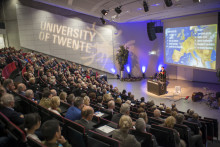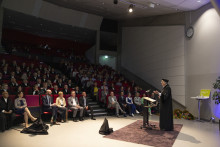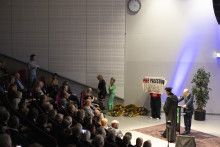Organized every year on the last Friday of November, the Dies Natalis is a ceremony celebrating the birthday of the University of Twente. With the 56th Dies ahead of us, let’s take a look ‘under the hood’ and explore all the small things that might often go unnoticed, but that make the Dies what it is.
Who better to guide us through it than the UT’s two beadles, alias the masters of ceremony, Wim Koehorst and Antoinette ten Veen-Wessels? After all, it is the beadles (pedellen in Dutch) that are responsible for ensuring the Dies ceremony doesn’t get derailed; and there are many rules and traditions they have to keep in mind.

On the photo: The two beadles of the University of Twente.
Correct procedure
‘We begin with three knocks on the floor,’ starts Wim Koehorst, but his colleague Antoinette ten Veen-Wessels instantly jumps in: ‘No, the first order of business is the photo.’ Indeed, before the actual Dies ceremony commences, it is traditional to take a photo with the entire ‘cortege’ (procession of professors) and members of the UT executive board. However, as soon as the picture is taken, the board members (with the exception of the rector) are asked to find their seats in the ceremony hall, because – based on the correct procedure – they should not enter together with the academic cortege.

With the mandatory photo taken, the beadles line up the procession of professors, who are to enter the hall in a very specific order. The cortege is led by the beadles, both of whom are always present at the Dies. They are followed by the rector, the main Dies speaker, former rectors of the university, the five deans of UT faculties, scientific directors, the scientific ambassador, external professors, retired professors formerly working at the UT and finally the current professors. ‘Always, always in this order,’ stress the beadles.
The music
When the procession is entering the room, the audience is meant to stand up. If you miss the three knocks of the beadle’s mace, hinting that you should get up from your seat, you will be reminded by the traditional piece of music that begins to play – or that is sung by a choir, as it’s been done in the past several years. The piece of music now associated with the beginning and the end of the Dies celebration is called Gaudeamus Igitur.

‘Although the song is traditionally used, it wasn’t always played,’ clarifies Ten Veen-Wessels. ‘It was played for many years at the UT, but at some point they stopped using it. The tradition was restarted about three years ago.’
Gaudeamus Igitur
The Latin song Gaudeamus Igitur (‘So Let Us Rejoice’ in English) is a popular academic commercium song, which is also used at many other universities besides the UT. Even though is it now performed at formal academic occasions, it has its origins as a beer-drinking song and consists of joyful, ironic lyrics.
The ceremony
Music is present also during the ceremony itself, in a form of musical intermezzos, each year performed by a different artist. How are they selected? ‘Although a large team is involved in organizing the event, the Dies is basically in the hands of the rector. You could say that Dies is a party hosted by rector Thom Palstra, while the Opening Academic Year ceremony is a party hosted by the UT chairman Victor van der Chijs,’ laughs Ten Veen-Wessels.

The welcome speech at the Dies is given by the Rector Magnificus, who then also introduces the main speaker that presents the traditional Dies Lecture. Besides this lecture, which is always in the hands of a different expert and on a different topic, the UT’s Dies Natalis is the occasion for handing out the Overijssel PhD Award and the Professor De Winter Prize.

Once the program comes to an end, Gaudeamus Igitur begins to play again and the beadles return to guide the cortege out of the room. ‘On the way out, however, the procession also needs to include the board members and the award winners,’ specifies Wim Koehorst. ‘When everyone is out of the hall, it is time for congratulating the award winners and, of course, for the reception.’

Clothing
‘No professor enters the Dies ceremony without being properly dressed,’ stresses Koehorst. ‘That means they have to be wearing the ceremonial gown and black – and polished! – shoes.’ While external professors are allowed to wear their own gown, UT professors put on the traditional black gown with green lining, specific to the University of Twente. ‘We use a specialized gown maker,’ continues Koehorst. ‘By the way, he always says that our gowns are the most difficult to make, because of the pleating on the sleeves.’

The dress code doesn’t end there. All members of the cortege also wear a beret, but: ‘The beret should only be worn during the walk in and on the way out of the hall. The speakers should also have it on during their speeches. However, it should never be worn when the person is seated – with the exception of ladies, who can choose to leave it on during the entire ceremony,’ says Ten Veen-Wessels.
Accessories
The Dies (and other formal academic ceremonies) would not be complete without a few other ‘accessories’. The metal chain worn by the rector, for one. The beadles inform us that the chain was given to the UT by the universities of Eindhoven and Delft in 1964. ‘It is made of silver and covered in gold,’ clarifies Koehorst. ‘The main emblem on it represents the coat of arms of Enschede. In fact, the mayor of Enschede has exactly the same chain.’
In 1964, the UT also obtained the traditional mace used by the beadles. On top of the mace, you can find a little silver statue of birds flying out of the nest. ‘It’s meant to represent the students graduating and flying off to the world,’ thinks Koehorst. ‘We also have a younger mace – from 1992 - with a different motive on the top, symbolizing the growth of the university.’
The Dies involves a lot more than meets the eye. As the people making it happen, why do the beadles think it is so important to celebrate this academic tradition? ‘It is the university’s birthday. And we are proud of our protocol, proud of the way we work here,’ answers Wim Koehorst and his colleague Antoinette ten Veen-Wessels adds: ‘It is such a hectic day, but it is also such a special day for us.’
Would you like to see all of the above in action? You can still register for tomorrow’s 56th Dies Natalis.









